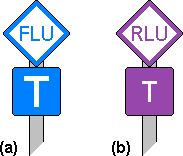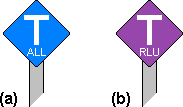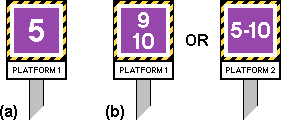Section 21: Stopping Markers
(Page 8 of 9)
|
Following the introduction of Class 380 'Desiro' electric multiple units on the Ayrshire Coast Line, special stop markers were provided on the approach to certain stop signals. Each marker takes the form of a train class specific notice board (see [26.20]) with the legend "class 380" at the top and the words "stop here" in the middle [21.153]. Stopping a Class 380 at this sign ensures that the train's pantograph does not come to rest too close to any nearby booster transformer or neutral section.
|
 |
[21.153] Class 380 Stop Marker.
Area: Ayrshire Coast Line
Usage: Medium
Status: Current
|
|
|
Special stop markers bearing a letter "X" [21.154] were installed at the north end of Norwood Junction station in December 2011. These signs apply only to 8-car Class 171 'Turbostar' diesel multiple units shunting out of Selhurst Depot. Stopping at this marker ensures that the train is accommodated within the platform before the driver changes ends.
|
 |
[21.154] Class 171 Stop Marker.
Area: Norwood Junction
Usage: Low
Status: Current
|
|
Where a platform has alternative stopping positions for trains of different lengths, there is a risk that a driver may stop the train at the wrong car stop marker. In some instances, the risk can be eliminated by defining a common stopping point for all trains. Where this is not practicable or desirable, other measures can be put in place. From 2012, special signage was provided at certain stations, designed to help drivers stop their trains at the correct position along the platform. The car stop markers are uniquely coloured according to train length [21.155]. There may also be a sign underneath, with an arrow showing on which side of the train the doors must be released and encouraging the driver to pause before doing so [21.156]. At the start of each platform concerned, there is a preliminary sign prompting the driver to check the formation of the train and showing which colour of stop marker to look out for [21.157].
 |
 |
 |
[21.155] Car Stop Markers (e.g. 3 and 6 car).
Area: Various
Usage: Medium
Status: Current
|
[21.156] Car Stop Marker with Door Release Reminder Sign (e.g. 4 car).
Area: Various
Usage: Low
Status: Current
|
[21.157] "Check" Sign (e.g. 4 / 8 / 12 car).
Area: Various
Usage: Medium
Status: Current
|
From c.2012, new car stop markers were provided at stations on the West Coast Main Line. The legend at the top of each board denotes the applicable class of train, which in most cases is either "Class 22x" or "Class 390" for Class 220/221 'Voyager' or Class 390 'Pendolino' trains, respectively [21.158]. No train operating company name is specified. A 'precision' stop marker is suffixed with the letter "X" and also bears the word "precision" [21.159]. Where Selective Door Operation applies, the board has a blue background and the letters "SDO" are added [21.160]. Where necessary, separate stop markers are installed for Class 390 trains hauled by Class 57 diesel locomotives [21.161].
 |
 |
[21.158] Car Stop Marker (e.g. applicable to Class 22x trains).
Area: West Coast Main Line
Usage: High
Status: Current
|
[21.159] Precision Car Stop Marker (e.g. applicable to Class 390 trains).
Area: West Coast Main Line
Usage: Low
Status: Current
|
 |
 |
[21.160] Car Stop Marker / SDO Board (e.g. applicable to Class 390 trains).
Area: West Coast Main Line
Usage: Low
Status: Current
|
[21.161] Stop Marker applicable to loco-hauled Class 390 trains.
Area: West Coast Main Line
Usage: Low
Status: Current
|
|
In May 2012, a sign displaying a letter "P" [21.162] was installed at the south end of Platform 2 at Oxford station. This sign is folded shut when not in use. When the sign is opened, and providing that the platform line is clear throughout, drivers must ignore the usual stop marker applicable to their train and must instead stop at the "VT 8/10" car stop marker at the north end of the platform.
|
 |
[21.162] "P" Sign.
Area: Oxford
Usage: Low
Status: Current
|
|
|
A car stop marker applicable to South West Trains services may have a reminder to drivers to check the aspect shown by the platform starting signal, where provided. The text "check signal!" appears at the top and bottom of the marker, on a white background with blue and white diagonally striped edging on either side [21.163].
|
 |
[21.163] Car Stop Marker with reminder to check signal (e.g. applicable to 8-car Class 455 trains).
Area: South West Trains
Usage: Low
Status: Current
|
|
|
A stop marker bearing the legend "4W car stop" [21.164] was installed at Platform 1A at Bedford station in August 2014. This marker applied to 4-car electric multiple units that required to use the carriage wash facility.
|
 |
[21.164] "W" Car Stop Marker.
Area: Bedford
Usage: Low
Status: Historical
|
|
From October 2015, stop markers of a diagonal shape were provided at stations on the Govia Thameslink Railway network in connection with the introduction of new Class 700 electric multiple units. These are fixed length units, formed of either eight or twelve cars. Stop markers applicable to 12-car units bear the letters "FLU" for 'full length unit' [21.165], while those applicable to 8-car units have "RLU" for 'reduced length unit' [21.166]. Stop markers applicable to both full length and reduced length units bear the word "all" [21.167]. Where Selective Door Operation applies, the letters "SDO" appear on the marker's upper edges [21.168]. A stop marker indicating the stopping position for services turning back was originally provided with a supplementary "T" sign [21.169]. Turnback markers were later introduced with the letter "T" and the appropriate train length legend both appearing on the same sign [21.170].
 |
 |
 |
[21.165] Class 700 Stop Marker for Full Length Units.

Area: Govia Thameslink Railway
Usage: Medium
Status: Current
|
[21.166] Class 700 Stop Marker for Reduced Length Units.
Area: Govia Thameslink Railway
Usage: Medium
Status: Current
|
[21.167] Class 700 Stop Marker for All Units.
Area: Govia Thameslink Railway
Usage: Medium
Status: Current
|
 |
 |
 |
[21.168] Class 700 Stop Marker / SDO Board (e.g. for all units).
Area: Govia Thameslink Railway
Usage: Medium
Status: Current
|
[21.169] Class 700 Stop Markers for services turning back ( (a) - e.g. for full length units; (b) - for reduced length units ).
Area: Govia Thameslink Railway
Usage: Medium
Status: Obsolescent
|
[21.170] Class 700 Stop Markers for services turning back ( (a) - e.g. for all units; (b) - for reduced length units ).
Area: Govia Thameslink Railway
Usage: Medium
Status: Current
|
|
A stop marker that applies to Class 700 units may be set against a square background with black and yellow diagonal stripes [21.171].
|
 |
[21.171] Class 700 Stop Marker (e.g. for all units).
Area: Govia Thameslink Railway
Usage: Low
Status: Current
|
|
Car stop markers bearing various letters are provided on Platform 1 at Banbury station [21.172]. In the Down direction, markers with the letters "A" and "C" are situated near the middle and the north end of the platform, respectively. In the Up direction, markers with the letters "X" and "Z" are situated near the middle and the south end of the platform, respectively. The "A" and "X" markers at the middle of the platform are located on either side of an axle counter train detection boundary. Through trains will usually stop at the appropriate "C" or "Z" marker, and terminating trains will usually stop at the appropriate "A" or "X" marker to leave the other portion of the platform free for another train.
 |
[21.172] Car Stop Markers.
Area: Banbury
Usage: Low
Status: Current
|
|
Although a car stop marker bearing a letter "S" usually applies to all trains, in some instances a supplementary plate may be provided to indicate that it does not apply to trains of a specific length or class [21.173].
|
 |
[21.173] "S Car Stop" Marker with "Trains Other Than" Plate (e.g. not applicable to 8-car Class 455 trains).
Area: South West Trains
Usage: Low
Status: Current
|
|







